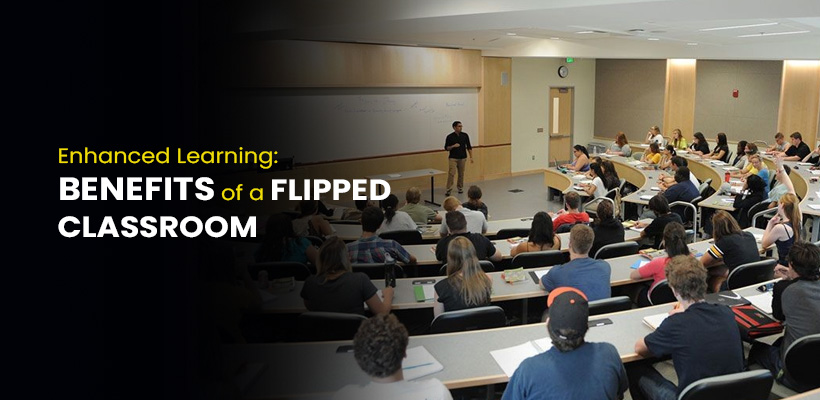In the dynamic realm of education, where innovation is the key to unlocking the full potential of learners, the flipped classroom has emerged as a transformative pedagogical approach. It challenges the traditional model by flipping the conventional order of instruction. This method of teaching can be implemented across different levels of learning, including schools and colleges. It is important for the top engineering colleges in India to adopt this pedagogical approach to ensure that students are prepared for a dynamic future in their field of study.
Let’s delve into the essence of the flipped classroom, exploring its benefits, challenges, and its potential to revolutionise education.
Tailored Learning in a Flipped Classroom
In a traditional classroom setting, students often passively receive information from teachers. The flipped classroom, however, disrupts this norm by shifting the learning paradigm. Teachers provide instructional content through videos or online resources for students to engage with before class. This approach allows for a personalised learning experience, catering to the individual pace and preferences of each student.
One of the defining characteristics of the flipped classroom is its ability to tailor content to individual needs. Students have the flexibility to revisit materials, delve deeper into specific topics, or seek additional resources based on their understanding. This customisation fosters a sense of autonomy and responsibility for one’s own learning journey.
Active Engagement through Flipped Learning
Flipped learning goes beyond merely watching videos; it embraces interactive platforms that promote engagement and collaboration. Students, armed with pre-class knowledge, actively participate in discussions, group activities, and problem-solving exercises during class time. This shift from passive consumption to active engagement is at the core of the flipped classroom’s effectiveness.
Collaborative learning opportunities abound in a flipped classroom setting. Students work together to apply theoretical concepts to real-world scenarios, fostering teamwork and communication skills. This collaborative spirit not only enhances academic performance but also prepares students for the demands of a connected, globalised society.
Improvement of Essential Skills
Beyond subject-specific knowledge, the flipped classroom nurtures essential skills crucial for success in the 21st century. Critical thinking and problem-solving skills are honed as students grapple with concepts independently before engaging in class discussions. The emphasis on communication and collaboration prepares them for a workforce that values teamwork and interpersonal skills.
Digital literacy, a skill increasingly vital in today’s tech-driven world, is naturally integrated into the flipped learning model. Students navigate online resources, interact with multimedia content, and develop a proficiency in using digital tools—a valuable asset in an era dominated by technology.
Adopting Challenges
While the flipped classroom holds immense promise, it is not without challenges. The digital divide, characterised by disparities in access to technology and the internet, poses a significant obstacle. Bridging this gap is essential to ensure equitable access to the benefits of flipped learning.
Motivating students in a flipped model also requires careful consideration. The autonomy provided can be empowering for some but daunting for others. Educators must implement strategies to keep students motivated, emphasising the relevance and real-world application of the content.
Time management for teachers is another hurdle. Designing and curating online materials, providing timely feedback, and managing in-class activities demand effective time allocation. Professional development opportunities can equip educators with the skills needed to navigate these challenges successfully.
Thoughtful Implementation of Flipped Classroom
Successful implementation of the flipped classroom hinges on thoughtful planning and support structures. Educators need adequate professional development to create effective online content, utilise interactive tools, and facilitate meaningful in-class activities. Additionally, fostering an inclusive learning environment is crucial to accommodate diverse learning styles and preferences.
Adapting to evolving educational needs is an ongoing process. The flipped classroom model is not a one-size-fits-all solution. Flexibility and responsiveness to the changing landscape of education ensure its continued relevance and effectiveness.
Constant Support for Flipped Learning
Continuous professional development is paramount in sustaining the success of flipped learning initiatives. Educators must stay abreast of emerging technologies, pedagogical approaches, and best practices in flipped instruction. A well-maintained technological infrastructure is also essential to support the seamless integration of digital resources.
Monitoring and evaluation mechanisms should be in place to assess the impact of flipped learning on student outcomes. Data-driven insights can inform adjustments and improvements, ensuring a constant cycle of refinement and enhancement.
Traversing Complexities in Education
Balancing traditional and flipped approaches is a delicate act. Educators must find a harmonious blend that capitalises on the strengths of each model. Overcoming resistance to change is a common challenge, and effective communication about the benefits of flipped learning is key in garnering support from stakeholders.
Maximising the benefits of flipped learning requires strategic planning and collaboration among educators, administrators, and parents. A holistic approach that considers the unique needs of the learning community ensures a smooth transition and maximises the positive impact of the flipped classroom.
Revolutionising Education with Flipped Classroom
The transformative potential of the flipped classroom is undeniable. As it addresses the shortcomings of traditional instruction and embraces innovative pedagogy, it stands as a beacon of change in education. By preparing students for a dynamic world, the flipped classroom plays a pivotal role in shaping the future of education.
Conclusion
In the ever-changing landscape of education, the flipped classroom offers a promising avenue for educational transformation. While challenges persist, a commitment to addressing them, promoting inclusivity, and adapting to evolving needs positions the flipped classroom as a powerful force in education. As educators and institutions navigate complexities, the potential for the flipped classroom to revolutionise education remains evident.

